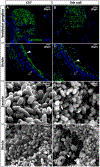The Price of Immune Responses and the Role of Vitamin D in the Inner Ear
- PMID: 31194714
- PMCID: PMC6578582
- DOI: 10.1097/MAO.0000000000002258
The Price of Immune Responses and the Role of Vitamin D in the Inner Ear
Abstract
Objective: In this review the authors discuss evidence from the literature concerning vitamin D and temporal bone diseases (benign paroxysmal positional vertigo [BPPV], Menière's disease [MD], vestibular neuritis, idiopathic facial paralysis, idiopathic acute hearing loss). Common features shared by Menière's disease, glaucoma, and the possible influence by vitamin D are briefly discussed.
Data sources, study selection: Publications from 1970 until recent times have been reviewed according to a keyword search (see above) in PubMed.
Conclusions: MD, BPPV, vestibular neuritis, idiopathic facial paralysis, idiopathic acute hearing loss may all have several etiological factors, but a common feature of the current theories is that an initial viral infection and a subsequent autoimmune/autoinflammatory reaction might be involved. Additionally, in some of these entities varying degrees of demyelination have been documented. Given the immunomodulatory effect of vitamin D, we postulate that it may play a role in suppressing an eventual postviral autoimmune reaction. This beneficial effect may be enhanced by the antioxidative activity of vitamin D and its potential in stabilizing endothelial cells. The association of vitamin D deficiency with demyelination has already been established in other entities such as multiple sclerosis and experimental autoimmune encephalitis. Mice without vitamin D receptor show degenerative features in inner ear ganglia, hair cells, as well as otoconia. The authors suggest further studies concerning the role of vitamin D deficiency in diseases of the temporal bone. Additionally, the possible presence and degree of demyelination in these entities will have to be elucidated more systematically in the future.
Figures




Similar articles
-
[Non-drug therapy of vertigo].Zh Nevrol Psikhiatr Im S S Korsakova. 2018;118(8):38-42. doi: 10.17116/jnevro201811808138. Zh Nevrol Psikhiatr Im S S Korsakova. 2018. PMID: 30251976 Russian.
-
Association of benign paroxysmal positional vertigo with vitamin D deficiency: a systematic review and meta-analysis.Eur Arch Otorhinolaryngol. 2018 Nov;275(11):2705-2711. doi: 10.1007/s00405-018-5146-6. Epub 2018 Oct 9. Eur Arch Otorhinolaryngol. 2018. PMID: 30302575
-
[Analysis of clinical features of secondary benign paroxysmal positional vertigo].Lin Chuang Er Bi Yan Hou Tou Jing Wai Ke Za Zhi. 2019 Mar;33(3):220-224. doi: 10.13201/j.issn.1001-1781.2019.03.009. Lin Chuang Er Bi Yan Hou Tou Jing Wai Ke Za Zhi. 2019. PMID: 30813689 Chinese.
-
Clinical application of cVEMPs and oVEMPs in patients affected by Ménière's disease, vestibular neuritis and benign paroxysmal positional vertigo: a systematic review.Acta Otorhinolaryngol Ital. 2019 Oct;39(5):298-307. doi: 10.14639/0392-100X-2104. Acta Otorhinolaryngol Ital. 2019. PMID: 31708577 Free PMC article.
-
[The peculiar features of the clinical course of Meniere's disease associated with benign paroxysmal positional vertigo].Vestn Otorinolaringol. 2018;83(1):32-35. doi: 10.17116/otorino201883132-35. Vestn Otorinolaringol. 2018. PMID: 29488493 Russian.
Cited by
-
Effect of vitamin D supplementation on benign paroxysmal positional vertigo recurrence: A meta-analysis.Sci Prog. 2021 Apr-Jun;104(2):368504211024569. doi: 10.1177/00368504211024569. Sci Prog. 2021. PMID: 34128742 Free PMC article.
-
Association between vitamin D deficiency and benign paroxysmal positional vertigo (BPPV) incidence and recurrence: a systematic review and meta-analysis.BMJ Open. 2024 Apr 22;14(4):e077986. doi: 10.1136/bmjopen-2023-077986. BMJ Open. 2024. PMID: 38653514 Free PMC article.
-
[Serum 25-hydroxyvitamin D expression and its correlation in patients with vestibular neuritis].Lin Chuang Er Bi Yan Hou Tou Jing Wai Ke Za Zhi. 2022 Aug;36(8):607-612. doi: 10.13201/j.issn.2096-7993.2022.08.008. Lin Chuang Er Bi Yan Hou Tou Jing Wai Ke Za Zhi. 2022. PMID: 35959579 Free PMC article. Chinese.
-
Differential Volume Increase of Endolymphatic Compartments in Ménière's Disease Is Inversely Associated With Membrane Thickness.Otol Neurotol. 2023 Sep 1;44(8):e588-e595. doi: 10.1097/MAO.0000000000003960. Epub 2023 Jul 18. Otol Neurotol. 2023. PMID: 37464462 Free PMC article.
-
Sensorineural Hearing Loss and Wernicke Encephalopathy: A Case Report and Literature Review.J Audiol Otol. 2021 Jan;25(1):55-58. doi: 10.7874/jao.2020.00045. Epub 2020 Jun 12. J Audiol Otol. 2021. PMID: 32521993 Free PMC article.
References
-
- Jeong SH, Kim JS, Shin JW et al. Decreased serum vitamin D in idiopathic benign paroxysmal positional vertigo. J Neurol 2013;260:832–8. - PubMed
-
- Talaat HS, Abuhadied G, Talaat AS et al. Low bone mineral density and vitamin D deficiency in patients with benign positional paroxysmal vertigo. Eur Arch Otorhinolaryngol 2015;272:2249–53. - PubMed
-
- Talaat HS, Kabel AM, Khaliel LH et al. Reduction of recurrence rate of benign paroxysmal positional vertigo by treatment of severe vitamin D deficiency. Auris Nasus Larynx 2016;43:237–41. - PubMed
-
- Meghji S, Murphy D, Nunney I et al. The Seasonal Variation of Benign Paroxysmal Positional Vertigo. Otol Neurotol 2017;38:1315–8. - PubMed
Publication types
MeSH terms
Grants and funding
LinkOut - more resources
Full Text Sources
Medical

